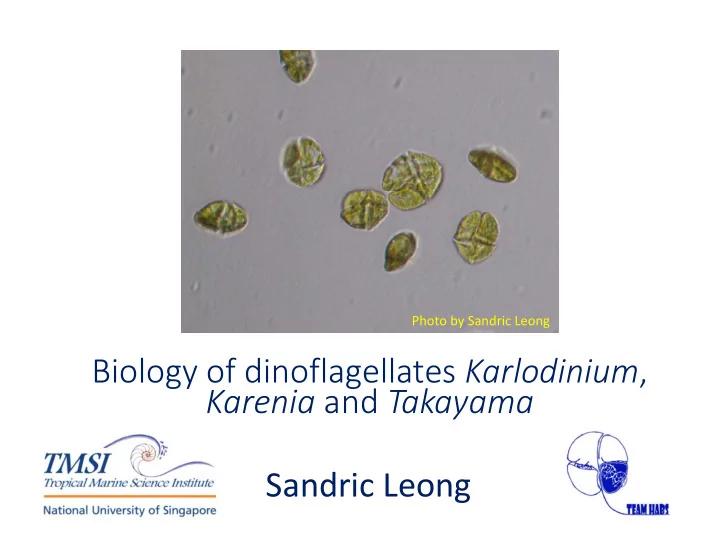

Photo by Sandric Leong Biology of dinoflagellates Karlodinium , Karenia and Takayama Sandric Leong
Kareniaceae The family Kareniaceae was established in 2005 and it consisted of the genera Karenia , Karlodinium and Takayama . Kareniaceae: 30 species Genus Karenia : 12 species Genus Karlodinium : 11 species Genus Takayama : 7 species http://www.sptimes.com/2004/04/02/State/Dolph in_deaths_still_.shtml Species of these genera are known to form harmful blooms around the global coastal areas. Some of the species could produce ichthyotoxins such as brevetoxins and karlotoxins that could cause marine animal illness and even mortality.
Karenia species • Genus Karenia is a marine unarmored/naked dinoflagellate 12 species • Species of the genus can be found throughout 1. Karenia asterichroma the world in both oceanic and coastal waters. 2. Karenia bicuneiformis 3. Karenia brevis • Most Karenia species could produce a variety of 4. Karenia brevisulcata toxins that could kill fish and other marine 5. Karenia concordia organisms when they form bloom. 6. Karenia cristata Botes 7. Karenia digitata • Karenia brevis is known to produce brevetoxin 8. Karenia longicanalis that could kills fish, marine mammals, and other 9. Karenia mikimotoi animals, and also causes neurotoxic shellfish 10.Karenia papilionacea poisoning and respiratory distress in humans. 11.Karenia selliformis 12.Karenia umbella • Some of the Karenia dinoflagellates grow slowly. • Karenia blooms are highly sporadic in both time and space.
Karenia mikimotoi Karenia mikimotoi is the oldest known species firstly described in Japan by Oda (1935) K. mikimotoi is a photosynthetic species that is widely distributed species and a known fish-killer that has caused economic losses in many countries. It produces complex toxic metabolites but the fish-killing mechanisms have not been recognized. Cells size range from 18 - 40μm in length and14 - 35μm in width Known toxins: Gymnocin-A; Gymnocin-B; Hemolysin (lipids and proteins that destroy red blood cells); PUFA (Poly-Unsaturated Fatty Acid) Human impacts: None known Animal impacts: Mortality of fish and invertebrates Distribution: Europe, America, Gulf of Mexico, Australia, New Zealand, Japan, Hong Kong, S. Korea, Singapore, the Philippines, China
Karenia mikimotoi Karenia mikimotoi is oldest known species described in Japan by Oda (1935) Light: low to high light (Saturation around 200 µmol photon m -2 s -1 ) Temperatures: 4 – 31°C Salinity: 9 – 35 PSU Nutrient requirement/preference: Reduced and Oxidized nitrogen (current work) Allelochemistry and toxin production: hemolytic activity; allelopathic effects of K. mikimotoi PUFAs on diatoms Bloom dynamics: form bloom with other species (current observation)
Karenia mikimotoi There are two distinct sub‐groups based on geographical regions (Al‐ Kandari et al. (2011) Al‐Kandari et al. (2011 )
Identification of Karenia mikimotoi • Identify using light microscope • Molecular technique Steidinger et al. (2008)
Karlodinium species 11 species • Genus Karlodinium is a marine unarmored/naked dinoflagellate 1. Karlodinium antarcticum • Karlodinium veneficum can be found 2. Karlodinium armiger throughout the global coastal waters. 3. Karlodinium australe 4. Karlodinium ballantinum • Some species are associated with fish 5. Karlodinium conicum mortality. 6. Karlodinium corrugatum 7. Karlodinium corsicum • Species are known to be mixotrophic like K. 8. Karlodinium decipiens veneficum and K. australe 9. Karlodinium gentienii 10.Karlodinium veneficum • Karlotoxins only found in K. veneficum 11.Karlodinium vitiligo
Karlodinium australe K. australe is capable of performing photosynthesis as well as feed on other organisms (mixotrophy). Cells size range from 19-26μm in length and16-22μm in width Known toxins: unknown Human impacts: None known Animal impacts: Mortality of fish Distribution: Australia, Malaysia, Singapore
Karlodinium australe Light: unknown Temperatures: 28 – 32.5°C (Singapore) Salinity: 21 – 30 PSU (Singapore) Nutrient requirement/preference: Reduced nitrogen and organic nitrogen (current work) Allelochemistry and toxin production: unknown Bloom dynamics: ?
Karlodinium australe Nutrient requirement/preference: Reduced nitrogen and organic nitrogen (current work)
Karlodinium veneficum Cells size range from 9-17μm in length and 8-14μm in width Known toxins: karlotoxins (higher toxicity when grown in ammonium, low salinity, high temperature) Human impacts: None known Animal impacts: Mortality of fish Distribution: Europe, America, UK, Africa, New Zealand, Australia, Malaysia, Singapore, Korea, China (worldwide distribution) Light: unknown Temperatures: 10 – 30°C Salinity: 5 – 30 PSU https://microbewiki.kenyon.edu/ind ex.php/Karlodinium_veneficum Nutrient requirement/preference: Reduced, oxidized and organic nitrogen
Identification of Karlodinium australe & veneficum • Identify using light microscope • Molecular technique de Salas et al. (2005) Lim et al. (2014)
Takayama species 7 species 1. Takayama acrotrocha • Genus Takayama is a marine 2. Takayama cladochroma unarmored/naked dinoflagellate 3. Takayama helix 4. Takayama pulchella • Some species are known to be ichthyotoxic 5. Takayama tasmanica 6. Takayama tuberculata • Some are known as fish killers such as T. 7. Takayama xiamenensis tasmanica • Morphology well documented for many species (e.g. de Salas et al. (2008)
Takayama acrotrocha T. acrotrocha is marine photosynthetic dinoflagellate. Cells size range from 22-27μm in length and18-22μm in width Known toxins: unknown (capable of producing mucus) Human impacts: None known Animal impacts: Mortality of fish Distribution: Europe, Australia, New Zealand, Singapore de Salas et al. (2003) T. pulchella T. acrotrocha T. cladochroma
Takayama acrotrocha Light: 80 – 700 (Singapore) Temperatures: 28 – 32.5°C (Singapore) Salinity: 21 – 30 PSU (Singapore) Nutrient requirement/preference: Reduced and Oxidized nitrogen (current work) Allelochemistry and toxin production: unknown • Identify using light microscope • Molecular technique de Salas et al. (2008)
Current status of Kareniaceae species 1. Morphological descriptions Well covered for most species 2. Toxins Many studies were done on K. brevis & K. veneficum Studies showed a high degree of toxin variability and toxin type among strains. Place et al. (2012)
Topics of Interests 1. Killing mechanisms of Kareniaceae species Current status: not fully documented Existing knowledge: limited Knowledge needed: more studies are necessary 2. Toxins 3. Distribution 4. Life cycle of Kareniaceae species 5. Ecophysiology of Kareniaceae species 6. Environmental factors that will promote fish kills 7. Warning system? Mitigation strategy? 8. Resting cysts?
teamhabs.info
Recommend
More recommend